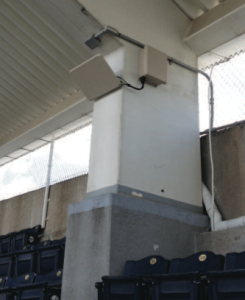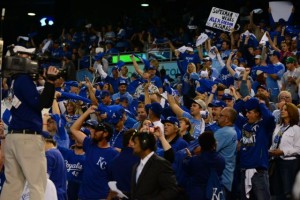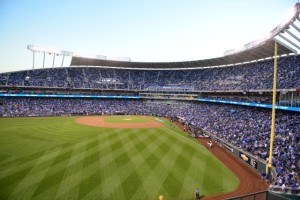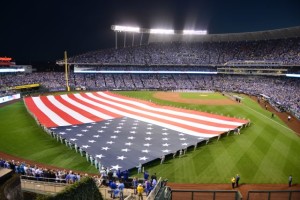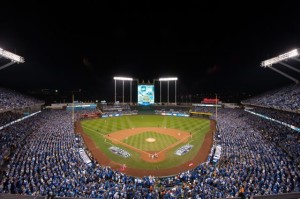
Kansas City’s Kauffman Stadium, during last year’s World Series. Photo: MLB Photos (click on any picture for a larger image)
While no team knows for sure if it can plan ahead for postseason play, the fact that Major League Baseball was able to complete its install of a Wi-Fi network at Kauffman Stadium last August ensured that the playoff and World Series crowds in Kansas City had high-bandwidth connectivity, finishing the season with a night that saw more than 2 terabytes of wireless traffic inside the stadium’s famed curved structures.
“The timing [of the installation] was somewhat fortuitous,” said Brian Himstedt, the Kansas City Royals’ senior director for information systems, who confirmed that plans for Wi-Fi were in motion long before the Royals gained their wild- card spot. According to Himstedt, the Royals had already been scheduled for one of the first deployments in the Major League Baseball Advanced Media (MLBAM) plan to bring Wi-Fi to every team in the league, with actual installation taking place in midsummer.
“The idea was to have it up and running during our last three homestands, and use that as a test- bed for the 2015 season,” Himstedt said. Instead, the Royals found themselves with perhaps the ultimate test of any new network deployment, repeat sellout crowds for baseball’s ultimate bucket-list event. Even though it wasn’t expected, as Himstedt said, having to maintain a network because your team got all the way to Game 7 of the World Series “is a good problem to have.”
Worth the wait for MLBAM deployment
Editor’s note: This story is reprinted from our latest Stadium Tech Report, the BASEBALL (and Soccer!) ISSUE, which is available now for free download from our site. The report includes a focus on baseball and soccer stadium technology deployments, and team-by-team coverage of technology deployments for all 30 MLS teams — AND all 20 MLS teams. DOWNLOAD THE REPORT now and read for yourself!
While MLBAM’s decision to pay for a major part of the league-wide deployments no doubt sped up the Wi-Fi timetable for many participants, Himstedt said that the rollout plan (which began in earnest last year) actually delayed an original timetable to bring Wi-Fi to Kauffman.
According to Himstedt, the Royals had investigated putting Wi-Fi into the stadium before the 2012 season, when Kansas City hosted the All- Star Game. But MLBAM convinced the team to wait until its connectivity-everywhere plan became reality, in no small part due to the technical, political and most-expenses-paid attributes that became part of MLB’s Wi-Fi and DAS push.
“When we investigated it [Wi-Fi] for 2012, BAM was already talking about their plan, and we saw the comprehensiveness of what they were talking about,” Himstedt said. “In some ways it slowed us down, but when it happened, it happened right.”
Perhaps one of the biggest attributes of the MLB plan was the league’s ability to work in concert with all four of the major cellular carriers in the U.S., not just in herding the cats together so that DAS deployments would include all carriers, but in also getting the carriers to agree to foot a significant portion of the overall deployment costs.
“Dealing with the complexity of politics that exists [between] the carriers, we wouldn’t have had what the league was able to do,” Himstedt said. “Back in September of 2012, I felt disappointed that we missed an opportunity to have it [Wi-Fi] for the All-Star Game. But looking back, I see all the mistakes we could have made. I’d have to say it was worth the wait.”Learning the curves
Opened in 1973, Kauffman Stadium has long been one of MLB’s more attractive parks, with its signature outfield fountains and its open, curved design. In 2009, the stadium underwent a $250 million renovation, which while it did not include wireless deployments it did help pave the way for Wi-Fi to come later, Himstedt said, with additions of more cable pathways and a “more robust” overall IT infrastructure.
Before the 2014 season started, Himstedt and the Kauffman Stadium IT team dug into the Wi-Fi design process, mapping out the resources and schedule for the in-season install that started in the summer.
“We knew it would take about 12 to 13 weeks [to install the network] after we said ‘go,’ “ Himstedt said. “When things began to flow we got a little but lucky with the weather and tried to plan [to do most of the work] around home stands. But we still did a lot of work on game days, right up until game time.”
Like in many other stadium retrofits, Himstedt said the biggest challenges for deploying Wi-Fi in Kauffman Stadium were “coverage and aesthetics.” Both came into play together due to the stadium’s circle-like design, which Himstedt noted means “there are no straight aisles” in the building, making it harder to deploy and tune antenna coverage.
While managing the gaps caused by the curved architecture was challenging, Himstedt said that new antenna technology from MLB supplier Cisco proved up to the task. “The [new] Cisco technology and its ability to shape signals definitely worked to our advantage, especially versus technology that was available 3 years ago,” Himstedt said.
More new Cisco technology that supports longer distances between an access point and a user also helped the Kauffman deployment, since the stadium has many long, open bowl areas with no close overhangs and no seating-section railings, two places that are popular in many other venues for Wi-Fi AP locations.
“We put antennas at the front of aisles, and in the back of the bowl, pointing down,” Himstedt said. The new antenna technology, he said, supported connectivity from 50 to 60 feet away, which he called a “huge win” for helping keep sight lines and aesthetic views uncluttered with antenna gear. When it was finished, the Wi-Fi deployment used 576 APs, Himstedt said.The quickly discovered ‘secret’
When the Wi-Fi network finally went live for an Aug. 25 night game, Himstedt and the Royals used what we here at MSR like to call the “Fight Club” method of non-promotion: First rule of Wi-Fi, is don’t talk about the Wi-Fi.
“We were 100 percent quiet – we didn’t mention it to anybody publicly,” said Himstedt of the network availability. The theory was, by not telling anyone the IT team could test and tune a live network over a few home stands, with only about 1,000 media members and internal staff using the Wi-Fi.
But a couple hours after turning the network on, the IT staff saw 3,000 users on the network, meaning that at least 2,000 or more fans had found and connected to the unannounced Wi-Fi. While outsiders might not think Kansas City is a place where citizens are always looking for an SSID, Himstedt said the locals are “probably the most unexpectedly tech savvy” group around, perhaps thanks to the nearby location of Sprint’s corporate headquarters, as well as the fact that Google Fiber brought its first services to Kansas City, spurring some local startup activity.
Throughout the end of the regular season and through the Royals’ extended playoff run, Himstedt and the Kauffman staff kept publicly silent about the Wi-Fi (“it was completely word-of-mouth”), though Major League Baseball did make a national-press announcement and some highly sophisticated stadium technology media outlets (meaning us) did publish stories about the Wi-Fi network’s availability.
Himstedt, who had wanted Wi-Fi for the All-Star Game, finally got to provide wireless services to the 600+ national media members who became regular attendees at playoff games. And by the time Game 7 of the World Series rolled around – and ended heartbreakingly for Royals fans, with the potential tying run 90 feet from home plate – the Kauffman IT staff saw 16,000 users on the Wi-Fi network, with more than 2 terabytes of total traffic used during the last game of the baseball season.“We enjoyed it [Wi-Fi] as being a pleasant surprise, an unexpected surprise for our fans,” Himstedt said.
Positioned for the future
For the 2015 season, the Kauffman Stadium IT crew is neither shy nor silent about its Wi-Fi network.
“This year we’re promoting it clear and direct, and we want fans to use it to its fullest extent,” said Himstedt. Along with promoting use of MLBAM’s signature Ballpark app for at-the-game needs, Himstedt said one of the team’s primary pushes is to encourage digital ticketing, a feature he said is already being used by all of the team’s primary season ticket holders.
Since the Kauffman Stadium complex also has all ticketed parking, those fees can also be paid via digital, a feature that went from hundreds of users to thousands this year, Himstedt said.
“The learning curve is fast – it’s pretty amazing how quickly fans adapt,” he said.
In the very near future, overall connectivity should improve by another factor as the stadium’s DAS upgrade is completed. Himstedt and his team are also just at the beginning phase of deploying and using beacons, the low-power sensing devices that can communicate with devices in close vicinity. While beacons are currently only being used for social media “check-in” purposes, Himstedt can see a future where the technology might be used for things like concession promotions, or to provide directions to areas like the venue’s Hall of Fame exhibits.
Himstedt is also interested in using the technology to take “check-ins” even further, with the network being able to automatically check a device for ticket purchases as the fan walks in the gates.
It’d be cool for the network to take the tickets out of my pocket for me,” Himstedt said. “The app is the magic. You just have to enable it.”
